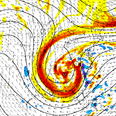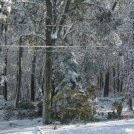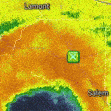All Activity
- Past hour
-
+PNA seems to be the most important pattern for big snow in the tristate at least. -EPO got us effing nothing last winter. Also need the subtropical jet to not be suppressed to oblivion
-
2007 was a much greater regime shift when looking at the bigger picture. The NSIDC didn’t forecast an imminent technically ice free summer below 1 million sq km at that time. But there were a few individuals in the Arctic community who did. If the record Arctic dipole pattern of 2007-2012 had continued into the 2020s, then the 2012 record would have been surpassed by now. Perhaps even producing a season in the 1 to 2 million sq km range approaching technically ice free. But the dipole reversal since 2013 featuring much lower summer pressures over the CAB has prevented the 2012 record from being challenged. 2020 came the closest but the relaxation of the dipole in August and lack of record Arctic cyclone preventing it from surpassing 2012. The last decade has featured a summer record mid-latitude ridging pattern across the Northern Hemisphere leading to the record heatwaves not on land and sea. It has featured lower pressures near the pole preventing a new record low. It’s interesting that a study released back in 2014 showed this new pattern developing before it emerged. They speculated at the time that it could lead to a remnant of summer Arctic sea ice remaining pretty far into the future if lower pressures continued over the Arctic during the summers going forward.
-

2025-2026 ENSO
brooklynwx99 replied to 40/70 Benchmark's topic in Weather Forecasting and Discussion
i would say that considering that -EPO and some +PNA is favored. definitely doesn't look like a disaster -
So 25-26 is dead in the water. Nice. Crazy the snow dropoff that has occured since 19-20. Really only one good winter since then, or really only one good month (Feb 2021).
-
What the heck is this thing? It’s on my wall. I hope that isn’t a tick. It’s not a spider, not enough legs.
-
Boris clients have signed extensions over the years. Yes he does like to take his ciients to Free agency but Boris works for the player. Not the other way around. Blaming the agent takes the blame away from the failure that Elias has been for the last 2 years. I'm pretty sure you work in the PR department at the warehouse.
-
Plenty of articles about that. But, maybe it is just a holding pattern for now, and then there will be another dip lower (or higher haha).
-
Occasional Thoughts on Climate Change
TheClimateChanger replied to donsutherland1's topic in Climate Change
I ran this scenario through AI and it confirmed that warming hole theory is not considering latent heat effects (increased water vapor), only sensible heat (dry bulb). Total heat (enthalpy) has likely continued to increase. In fact, if you consider latent heat effects, then places in the southwest with extreme sensible heat increases may actually have less total heat increase (since latent heat has decreased in those areas, evidenced by declining dewpoints). -
Rainer when?
-
I'm just reading the chart here from what Bluewave posted in the seas ice thread. I'm not sure it matters much in terms of enso compared to the past 15 years especially.
-
Those are some solid rollers!
-
Nice waves in Welfleet:
-
Some models are looking like our luck will change in September. How much do you want to bet this is like the late 2010s and there's an odd month where there's next to nothing for some reason? In 2017 it was December, in 2018 it was January, and in 2019 it was September.
-
Sunday storms could be sneaky severe. Something to keep an eye on.
-
It truly is. See this is the kind of early deal Boras can't stand, lolol So glad to see the effort from the org to extend a young star!
-
Oh. My. Goodness Ha...SEE WHAT HAPPENS WHEN BORAS ISN'T THE AGENT????? See this proves it...he is the reason we haven't extended anybody else (especially Gunnar). I was hoping Basallo didn't have him as an agent and thankfully he doesn't, lol
-
Yeah, None of this half COC shit.
-
zzzzzzzzzzz
-
My favorite time of the year, when all the Michigan posters panties get in a bunch and the infighting begins until the flakes fly.
-
With maybe a short fuse non (or sub) tropical critter for @Hazeyearly next week. Beneficial rains at least.
-
Early fall
-
Not my favorite but cannot complain about 70s and 80s with sun
- Today
-
Records: Highs: EWR: 94 (1983) what a difference a year makes NYC: 95 (1916) LGA: 93 (2019) JFK: 93 (1976) Lows: EWR: 51 (1982) NYC: 52 (1894) LGA: 55 (1982) JFK: 56 (1982) Historical: 1746: Salem, MA had a cold night, with "some frost so as to kill corn leaves" (Diary of Lt. John Preston ) 1816 - The growing season for corn was cut short as damaging frosts were reported from North Carolina to interior New England. (David Ludlum) 1821: A tornado ripped through Tybee Island, GA destroying a wing of the U.S. Army barracks. (Ref. Wilson Wx. History) 1851: A tornado ripped through Middlesex County in Massachusetts and injured 6 people. The tornado swept through Waltham, Belmont, West Cambridge, Arlington, and Medford. Six people died along with extensive damage. (Ref. NOAA Boston Weather Events) 1857: A tornado tore through Woodland, WI. Windstorm at Woodland, WI. Freight cars reportedly blown off railroad tracks. Although it leveled every building in the town, fortunately there were no deaths. (Ref. AccWeather Weather History) 1923 - The temperature at Anchorage, AK, reached 82 degrees, a record for August for the location which was later tied on the 2nd in 1978. (The Weather Channel) 1933: The Hampton Roads area of Virginia was hit on the night of the 22nd-23rd by its worst hurricane in history. Norfolk saw an 8 foot storm surge pushed through the streets of the city. Winds reached nearly 100 mph. 18 people were killed. (Ref. AccWeather Weather History) 1976: Heavy coastal rain 7.39 inches at Pocomoke City, VA but only a trace of rain in Washington, DC. 1980: Major flash flooding occurred in Kentucky as up to 3 inches of rain fell in a very short period. Heavy damage included flooded homes and washed out bridges and roads. Wichita Falls, TX reached 108° to establish a record for the date. 56 of the previous 59 days in Wichita Falls had reached a high temperature of 100 degrees or hotter. (Ref. AccWeather Weather History) New Orleans, LA hit 102° to establish their all-time record high temperature at the time. The new record is now 103 °F which occurred on August 30, 2000. (Extreme Weather p. 274, by Christopher C. Burt) 1985: Intense thunderstorms moved from near Shadehill Reservoir in northwest South Dakota late in the evening on the 21st, to northern Brown County after sunrise on this date. These thunderstorms produced strong winds, large hail, heavy rainfall and lightning. The strongest wind gust was reported in Hoven with a peak gust of 72 mph. Nine miles south and four miles west of Keldron, over two inches in diameter hail fell for 40 minutes, breaking windows and piling in ditches to a depth of four feet. These intense thunderstorms also produced brief heavy rainfall ranging from three quarters of an inch to over four inches. (Ref. Wilson Wx. History) 1987 - A cold front lowered temperatures 20 to 40 degrees across the north central U.S., and produced severe thunderstorms in Ohio and Lower Michigan. An early morning thunderstorm near Sydney MI produced high winds which spun a car around 180 degrees. (The National Weather Summary) (Storm Data) 1988 - Afternoon highs of 88 degrees at Astoria, OR, and 104 degrees at Medford, OR, were records for the date, and the number of daily record highs across the nation since the first of June topped the 2000 mark. (The National Weather Summary) 1989 - Evening thunderstorms in the central U.S. produced golf ball size hail at May City IA, and wind gusts to 66 mph at Balltown IA. Lightning struck a barn in Fayette County IA killing 750 hogs. Evening thunderstorms in Montana produced wind gusts to 70 mph at Havre. (The National Weather Summary) (Storm Data) 1992 - Hurricane Andrew makes landfall in Southern Florida as a Category 5 storm with wind guests estimated in excess of 175 m.p.h. Estimated damages exceeded $20 billion, more than 60 people were killed and approximately 2 million people were evacuated from their homes. (University of Illinois WW2010) 1994: Hurricane John, about 345 miles south of Hilo, Hawaii had winds of 175 mph and pressure at 920 millibars or 27.17 inches of mercury, making it one of the strongest hurricanes ever in the Central Pacific. The 31-day existence made John the longest-lasting tropical cyclone recorded in both the Pacific Ocean and worldwide, surpassing both Hurricane Tina's previous record in the Pacific of 24 days in the 1992 season and the 1899 San Ciriaco hurricane's previous world record of 28 days in the 1899 Atlantic season. John was also the farthest-traveling tropical cyclone in both Pacific Ocean and worldwide, with distance traveled of 7,165 miles, out-distancing previous record holders Hurricane Fico in the Pacific of 4,700 miles in the 1978 season and Hurricane Faith worldwide of 6,850 miles in the 1966 Atlantic season. 1998: Tropical Storm Charley was the second of 7 named tropical systems to strike the U.S. in 1998. But the most interesting event of Charley's arrival on the mainland would occur the next day, when 17.03 inches of rain fell in Del Rio, TX. This amount is nearly equal to the average rainfall for an entire year. It would establish their all-time record rainfall. 20 people died in flash flooding. (Ref. AccWeather Weather History) 1999: Tropical Storm Charley was the second of 7 named tropical systems to strike the U.S. in 1998. But the most interesting event of Charley's arrival on the mainland would occur the next day, when 17.03 inches of rain fell in Del Rio, TX. This amount is nearly equal to the average rainfall for an entire year. It would establish their all-time record rainfall. 20 people died in flash flooding. (Ref. Wilson Wx. History) 2002: Dubuque, Iowa: The Dubuque airport reports 8.96 inches of rain in a 24-hour period, setting a new record for the most rain in 24 hours. (Ref. WxDoctor)Described as a “blizzard” by town residents (and turning the ground white), a hailstorm battered Newman Grove, NE. Hailstones to tennis ball size were blown by 50-mph winds. 60-80% of the town’s homes were damaged; some had a dozen windows broken. (Weather Guide Calendar with Phenomenal Weather Events 2011 Accord Pub. 2010, USA) 2008: Severe thunderstorms produced large hail and strong winds over parts of eastern Wyoming and the Nebraska panhandle. A wind gust to 71 mph was recorded at the Chadron airport in Nebraska while 60 to 70 mph winds and hail up to 2 inches in diameter were reported around Douglas, WY.(Ref. Wilson Wx. History)







.thumb.png.4150b06c63a21f61052e47a612bf1818.png)









